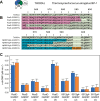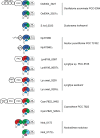Natural diversity provides a broad spectrum of cyanobacteriochrome-based diguanylate cyclases
- PMID: 34608946
- PMCID: PMC8491021
- DOI: 10.1093/plphys/kiab240
Natural diversity provides a broad spectrum of cyanobacteriochrome-based diguanylate cyclases
Abstract
Cyanobacteriochromes (CBCRs) are spectrally diverse photosensors from cyanobacteria distantly related to phytochromes that exploit photoisomerization of linear tetrapyrrole (bilin) chromophores to regulate associated signaling output domains. Unlike phytochromes, a single CBCR domain is sufficient for photoperception. CBCR domains that regulate the production or degradation of cyclic nucleotide second messengers are becoming increasingly well characterized. Cyclic di-guanosine monophosphate (c-di-GMP) is a widespread small-molecule regulator of bacterial motility, developmental transitions, and biofilm formation whose biosynthesis is regulated by CBCRs coupled to GGDEF (diguanylate cyclase) output domains. In this study, we compare the properties of diverse CBCR-GGDEF proteins with those of synthetic CBCR-GGDEF chimeras. Our investigation shows that natural diversity generates promising candidates for robust, broad spectrum optogenetic applications in live cells. Since light quality is constantly changing during plant development as upper leaves begin to shade lower leaves-affecting elongation growth, initiation of flowering, and responses to pathogens, these studies presage application of CBCR-GGDEF sensors to regulate orthogonal, c-di-GMP-regulated circuits in agronomically important plants for robust mitigation of such deleterious responses under natural growing conditions in the field.
© American Society of Plant Biologists 2021. All rights reserved. For permissions, please email: journals.permissions@oup.com.
Figures






Similar articles
-
Light-Regulated Synthesis of Cyclic-di-GMP by a Bidomain Construct of the Cyanobacteriochrome Tlr0924 (SesA) without Stable Dimerization.Biochemistry. 2017 Nov 21;56(46):6145-6154. doi: 10.1021/acs.biochem.7b00734. Epub 2017 Nov 8. Biochemistry. 2017. PMID: 29072834
-
Cyanobacteriochrome SesA is a diguanylate cyclase that induces cell aggregation in Thermosynechococcus.J Biol Chem. 2014 Sep 5;289(36):24801-9. doi: 10.1074/jbc.M114.583674. Epub 2014 Jul 24. J Biol Chem. 2014. PMID: 25059661 Free PMC article.
-
More than Enzymes That Make or Break Cyclic Di-GMP-Local Signaling in the Interactome of GGDEF/EAL Domain Proteins of Escherichia coli.mBio. 2017 Oct 10;8(5):e01639-17. doi: 10.1128/mBio.01639-17. mBio. 2017. PMID: 29018125 Free PMC article.
-
Cyanobacteriochromes: A Rainbow of Photoreceptors.Annu Rev Microbiol. 2024 Nov;78(1):61-81. doi: 10.1146/annurev-micro-041522-094613. Epub 2024 Nov 7. Annu Rev Microbiol. 2024. PMID: 38848579 Free PMC article. Review.
-
C-di-GMP Synthesis: Structural Aspects of Evolution, Catalysis and Regulation.J Mol Biol. 2016 Sep 25;428(19):3683-701. doi: 10.1016/j.jmb.2016.07.023. Epub 2016 Aug 4. J Mol Biol. 2016. PMID: 27498163 Review.
Cited by
-
Cyanobacteriochromes from Gloeobacterales Provide New Insight into the Diversification of Cyanobacterial Photoreceptors.J Mol Biol. 2024 Mar 1;436(5):168313. doi: 10.1016/j.jmb.2023.168313. Epub 2023 Oct 13. J Mol Biol. 2024. PMID: 37839679 Free PMC article.
-
Sensors and controllers-for and from plants.Plant Physiol. 2021 Oct 5;187(2):473-476. doi: 10.1093/plphys/kiab364. Plant Physiol. 2021. PMID: 34608975 Free PMC article. No abstract available.
-
Characterisation of sequence-structure-function space in sensor-effector integrators of phytochrome-regulated diguanylate cyclases.Photochem Photobiol Sci. 2022 Oct;21(10):1761-1779. doi: 10.1007/s43630-022-00255-7. Epub 2022 Jul 5. Photochem Photobiol Sci. 2022. PMID: 35788917 Free PMC article.
-
Gas and light: triggers of c-di-GMP-mediated regulation.FEMS Microbiol Rev. 2023 Jul 5;47(4):fuad034. doi: 10.1093/femsre/fuad034. FEMS Microbiol Rev. 2023. PMID: 37339911 Free PMC article. Review.
-
Protein-chromophore interactions controlling photoisomerization in red/green cyanobacteriochromes.Photochem Photobiol Sci. 2022 Apr;21(4):471-491. doi: 10.1007/s43630-022-00213-3. Epub 2022 Apr 11. Photochem Photobiol Sci. 2022. PMID: 35411484 Free PMC article.
References
-
- Anders K, Essen LO (2015) The family of phytochrome-like photoreceptors: diverse, complex and multi-colored, but very useful. Curr Opin Struct Biol 35: 7–16 - PubMed
-
- Beattie GA, Hatfield BM, Dong HL, McGrane RS (2018) Seeing the light: The roles of red- and blue-light sensing in plant microbes. Annu Rev Phytopathol 56: 41–66 - PubMed
-
- Blain-Hartung MD, Rockwell NC, Lagarias JC (2017) Light-regulated synthesis of cyclic-di-GMP by a bidomain construct of the cyanobacteriochrome Tlr0924 (SesA) without stable dimerization. Biochemistry 56: 6145–6154 - PubMed
-
- Burgie ES, Walker JM, Phillips GN Jr, Vierstra RD (2013) A photo-labile thioether linkage to phycoviolobilin provides the foundation for the blue/green photocycles in DXCF-cyanobacteriochromes. Structure 21: 88–97 - PubMed
Publication types
MeSH terms
Substances
Grants and funding
LinkOut - more resources
Full Text Sources

